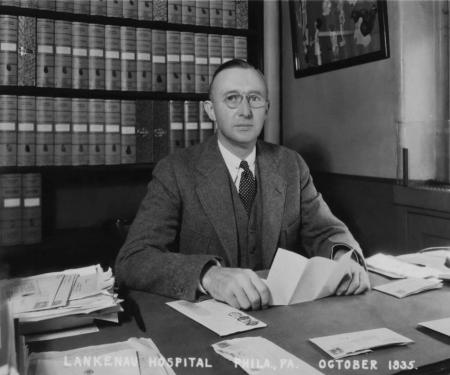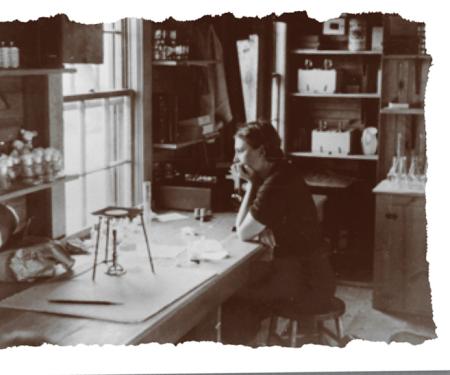Women Past and Present Have Played Key Roles at Fox Chase
BY PATRICK MCGEE
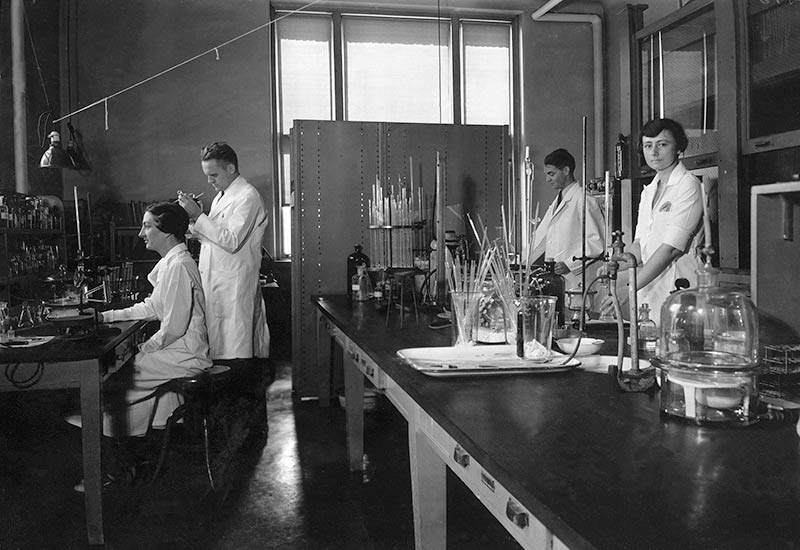
In 1989, Mary Daly, MD, PhD, FACP, came to Fox Chase Cancer Center with a medical degree and a doctorate in epidemiology, both of which she obtained when her three children were young.
When Daly joined Fox Chase, she met Scientific Director Anna Marie Skalka, PhD, who had come to the center in 1987. “That was pretty interesting. I mean, for a woman to be in charge of all these men doing research,” Daly said. Unbeknownst to Daly at the time, Fox Chase had a long history from its beginnings of women scientists playing leading roles in its labs and clinics.
In fact, as early as 1946, four of the institute’s 10 laboratory heads were women. And female researchers and physicians who bridge the gap between the laboratory and the clinic have continued to play a role in the achievements of Fox Chase to this day.
AN UNUSUAL APPROACH
In 1927, Stanley P. Reimann, MD, and Frederick Hammett, PhD, a biologist and biochemist, founded the Lankenau Hospital Research Institute, which later morphed into the Institute for Cancer Research before merging with the American Oncologic Hospital. The end result is what is now known as Fox Chase Cancer Center.
The two men had what seemed to be an odd premise to many of their fellow scientists and clinicians at the time: To learn about cancer and the abnormal cell growth that define it, it was necessary to study the normal growth and development of cells. They were ridiculed by many for the direction of their “so-called” cancer research.
The two did something equally unusual—they hired a number of women as researchers at a time when research labs were dominated by men.
This history was not accidental. In 1927, Reimann laid out a strategy for the type of research to be done and the people who would execute it. He wrote that the approach was “one in which a large problem is adopted with a unique staff to attack the problem by way of various disciplines and techniques.”
This “unique staff” included a number of women researchers who would go on to long, distinguished careers and become leaders in their fields. According to “Growth: A History of the Institute for Cancer Research,” Reimann’s confidence in the abilities of women as researchers “was perhaps one of the major factors that contributed to his success in spreading knowledge of cancer and in weathering the many crises he encountered in establishing the Lankenau Hospital Research Institute on a firm footing.” The history was written by Elizabeth Patterson, who was recruited by Reimann in 1944 after earning her doctorate at Bryn Mawr College.
REIMANN’S FIRST ASSISTANT
“Dr. Bennett’s early years at the laboratory in some ways mirror the stresses of women scientists to obtain their academic degrees and their independence at that time.”
— FROM “GROWTH: A HISTORY OF THE INSTITUTE FOR CANCER RESEARCH”
The first researcher that Reimann hired was Mary Adelia Bennett, who became his assistant. She started working part time with him in 1921, and he encouraged her to pursue graduate studies at the University of Pennsylvania, where she received a doctorate in physiological chemistry in 1926.
“Dr. Bennett’s early years at the laboratory in some ways mirror the stresses of women scientists to obtain their academic degrees and their independence at that time,” Patterson wrote. Bennett lived on very little money since she could only work part time while pursuing her doctorate. She was also caring for an invalid mother.
Her accomplishments include many journal publications throughout the 1940s and 1950s in general biochemistry. Some of that work included preparation of various liver extracts that led to the isolation of vitamin B12. She was also the recipient of the Robert McNeil Fellowship.
BENEFIT OF GEOGRAPHY
Philadelphia, where Fox Chase is located, has long been a center for scientific and medical education and research. The first medical school in the United States opened in 1765 at the College of Philadelphia and eventually evolved into the University of Pennsylvania’s Perelman School of Medicine. Scientists and physicians have long used the city as a starting point or a home base for their endeavors.
“The fact that a woman could get a PhD degree and then get a job was really different than in other parts of the world,” said Marilyn Bailey Ogilvie, professor emeritus in the Department of the History of Science at the University of Oklahoma. She is coeditor of “The Biographical Dictionary of Women in Science,” and the author of several books on the history of women in science.
Another unique thing was that women researchers at Fox Chase were being paid the same as their male counterparts. In a 1985 interview, Patterson said, “There was no discrimination whatsoever. Salaries were the same.”
Ogilvie said the pay was “very surprising” for its time. She also noted that generally, once women got into the laboratory, they trained other women to do the same work. “That’s the pattern that I’ve seen,” she said. That pattern of handing scientific knowledge down would recur throughout the history of Fox Chase, with one generation of women researchers passing their knowledge along to the next.
As the staff continued to grow, more women were brought on board, including Grace Medes, who earned her doctorate in zoology at Bryn Mawr in 1916. Before coming to the institute in 1932, she taught at Vassar and Wellesley and was an assistant professor of medicine at the University of Minnesota, where she became known for her work in biochemistry.
Despite her credentials, Reimann had a hard time convincing his colleague Hammett to take her on, and he was not helped much by the negative feedback he was getting from some of her colleagues at Minnesota. One wrote that although she was “a worker and cooperative,” she was also “eccentric as all hell.”
But Reimann remained undaunted, and wrote to Hammett that Medes wanted to work at the institute because she believed “we are doing the best work in the country.” He went on to press his case in a later letter to Hammett: “I just know we are going to get much good work from Grace Medes…. I shall back her to the limit.”
Once again, Reimann was on the mark, as Medes went on to a long and distinguished career, culminating in 1955 with the Garvan Medal (now the Garvan-Olin Medal) from the American Chemical Society for her work. She and Reimann co-authored a book, “Normal Growth and Cancer.”
During Medes’ late career at Fox Chase, two other female researchers appeared on the scene who would play a key role in groundbreaking work. One, Jenny Pickworth Glusker, DSc, arrived in 1956 after training with a Nobel Prize-winning scientist. In 1960 geneticist Beatrice Mintz, PhD, began a long and illustrious career in which she developed mouse models that allowed scientists to identify links between development and cancer.
BRIDGING THE GAP
As researchers like Glusker and Mintz worked in the confines of their labs, others like Daly were working to bridge the gap between the research lab and the clinic. After earning her doctorate from the University of North Carolina at Chapel Hill (UNC), Daly got a job in public health, but became frustrated because she realized she didn’t understand the diseases she was studying. “I knew how to design the studies and do the statistics, but I didn’t know the physiology of those diseases. So I figured at this point I had to go to medical school,” she said. Daly received her medical degree from UNC as well.
After an oncology fellowship, she knew she wanted to integrate her oncology and public health experience. “There weren’t many jobs that matched my vision. That is, I didn’t want to be someone who just did clinical trials in medicine. I wanted to bring in my epidemiology experience and look at prevention.”
She was brought to Fox Chase as the associate director of the Cancer Control Science Program by a pioneer in prevention, Paul Engstrom. She also brought her interest in genetics with her. “I started a makeshift genetics high-risk program, probably a year or two after coming here. It eventually blossomed into what is now the department of clinical genetics.”
ALREADY AN ACCOMPLISHED CAREER
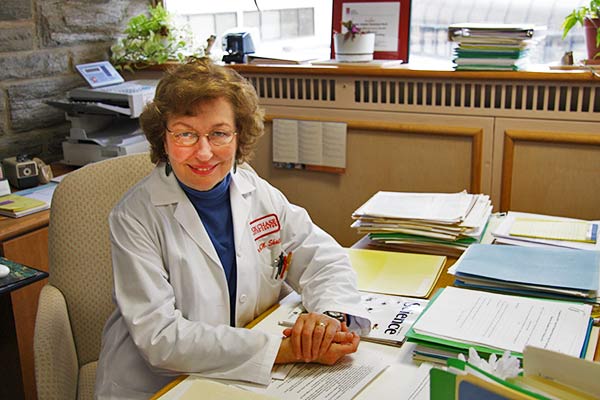
By the time she arrived at Fox Chase, the woman who had impressed Daly so much, Ann Skalka, already had an accomplished career. She spent 18 years at the Roche Institute of Molecular Biology, a basic research institution funded by the pharmaceutical company Hoffmann-LaRoche. She started as an assistant professor, immediately after postdoctoral training with Nobel laureate Alfred Hershey, and eventually rose to assistant vice president and head of the department of molecular oncology.
Skalka’s parents were immigrants who worked at a production plant for the pharmaceutical company Pfizer located in Williamsburg, Brooklyn. Pfizer offered part-time summer jobs to the children of employees, and that is how Skalka was first exposed to a working laboratory while in high school. The group she was assisting was experimenting with the use of various plant materials as possible screens for drug toxicities.
In a short memoir that was published in the scientific journal Annual Review of Virology, Skalka wrote that during that time she “discovered that science could be fun and scientists could be both interesting and kind.” In an interview, she said her career benefitted by being in large urban areas like New York and Philadelphia, where the i.e. of a woman scientist did not seem as foreign as it may have in other parts of the country.
Skalka went on to get a doctorate in microbiology from New York University Medical School and become internationally known for contributions to understanding how retroviruses replicate and insert their genetic material into the host genome. Although the most well-known retrovirus, HIV, causes AIDS, many retroviruses cause cancer in animals and some cause cancer in humans. Skalka’s work has greatly informed the study and treatment of both diseases.
RECOGNIZED ROLE MODELS
A year before Skalka came to Fox Chase, Margie Clapper, PhD, arrived, fresh from getting her doctorate in genetics and cell biology from the University of Connecticut at Storrs. Clapper grew up on a dairy farm in upstate New York and was intrigued by the intricacies of biological systems early in life. Her undergraduate laboratory experience at the State University of New York at Oneonta shaped her future career path.
After completing the requirements for veterinary school, she instead accepted a research opportunity as a technician in the laboratory of Norman Klein at UConn. Klein, focused on identifying the causes of abnormal embryonic development, quickly recognized her potential and encouraged her to enter the doctorate program. Her work revealed that anticonvulsants can induce birth defects in the offspring of mothers with epilepsy. In 1986, she began to apply her drug-related expertise to cancer as the first postdoctoral fellow in the newly formed Pharmacology Department at Fox Chase and has remained a leading researcher at the institution.
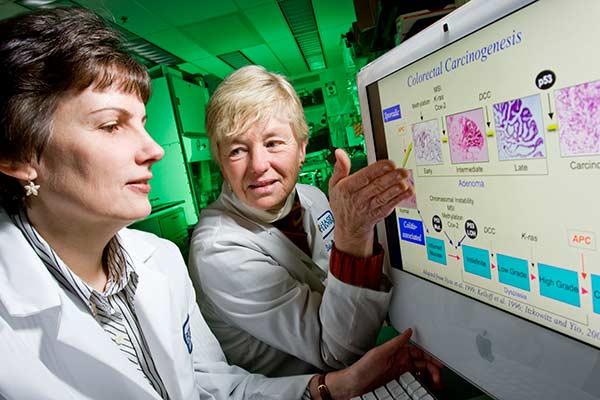
“With the opening of the Phase I clinical unit adjacent to our lab came unique opportunities to test new experimental therapies in patients with advanced-stage disease,” said Clapper. “Our ability to obtain biological specimens in real time from these courageous patients—literally bench to bedside—is an early example of what we now know as translational research.”
According to Clapper, it helped to have internationally recognized role models like Glusker and Mintz already here when she arrived. “The message from all of them was that you have to work hard and stick up for what you believe,” said Clapper, who was recently named the Samuel M.V. Hamilton Chair in Cancer Prevention. She has also been co-leader of the Cancer Prevention and Control program for the past decade and is a deputy chief science officer.
CLINICAL AND TRANSLATIONAL RESEARCH
Although much research at Fox Chase is laboratory based, the mission of a comprehensive cancer center also embraces clinical research across multiple areas of oncology. Respected faculty, including Elin R. Sigurdson, MD, Lori Goldstein, MD, Elizabeth Plimack, MD, and Margaret von Mehren, MD, lead clinical studies that help advance therapeutic options for patients.
In addition to clinical studies, von Mehren is very involved in translational research with a laboratory-based partner. Originally joining Fox Chase in 1993 for a fellowship in medical oncology, von Mehren is now physician director for the Clinical Trials Office and associate director for clinical research. One of the several forms of cancer she has done research on is gastrointestinal stromal tumors (GIST).
Some of that research is a collaboration with Lori Rink, PhD, an assistant professor in the Molecular Therapeutics Program. Rink, who got her doctorate in molecular biology at Temple University, came to Fox Chase in 2006 and has stayed to focus her research on GIST, a rare cancer, and Gleevec, a drug approved by the Food and Drug Administration in 2002 to treat GIST.
Prior to Gleevec, the only option for patients with GIST was surgery, so the drug has changed the lives of many patients. But for most, it eventually stops working, and Rink and von Mehren want to understand why. They have received large grants to investigate the problem and have also identified genetic markers that could predict how patients will respond to Gleevec. They are also investigating using a combination of drugs to attack GIST.
Prior to working with von Mehren, Rink had another mentor, but he took a position elsewhere, just as Rink received a prestigious five-year grant. The first two years of the grant required a mentor for training, so Rink turned to von Mehren and Erica Golemis, PhD, chair of the Molecular Therapeutics Program.
“I’m very grateful for both of them because you wonder what you’re going to do next once the person you’ve trained under has left,” she said. “Meg was very supportive and said, ‘I’m happy to stand in there as your mentor. I know you can do this.’ She had a strong belief that I could eventually run the lab.” Rink now has two graduate students and a postdoctoral fellow in her lab.
Rink said she feels very lucky having successful scientists such as von Mehren and Golemis in her corner. “I get two different perspectives, that clinical perspective from Meg, which is really, really important for a translational scientist, but also, some of the nitty gritty in terms of what methods or analyses to use from Erica.”
Golemis has a long history of working with up-and-coming researchers. She arrived in 1993 following an undergraduate degree at Bryn Mawr College, a doctorate from the Massachusetts Institute of Technology, and postdoctoral training in molecular biology and genetics at Massachusetts General Hospital and Harvard Medical School.
“I also thought that this would be a place where you could flourish as a person running a small independent laboratory that explored creative ideas.”
— ERICA GOLEMIS, DEPUTY CHIEF SCIENCE OFFICE, FOX CHASE CANCER CENTER
In addition to being a deputy chief science officer and leader of the Molecular Therapeutics Program, she is also the William Wikoff Smith Chair in Cancer Research. She is well known for her work in studying errors in cell signaling that cause aggressive tumor growth, as well as research aimed at improving the use of clinical agents that can selectively target tumors.
In her time at Fox Chase, Golemis has worked with dozens of graduate students, postdoctoral fellows, and clinical fellows. Golemis said she was attracted to Fox Chase because it seemed like it had a very collegial environment, where time spent mentoring the next generation of scientists would be valued.
“I also thought that this would be a place where you could flourish as a person running a small independent laboratory that explored creative ideas,” she said. She was also impressed by Skalka, who was the scientific director when she was first hired. “I thought Ann Skalka was a fantastically inspirational leader, a brilliant scientist, and a role model.”
THE NEXT GENERATION
Fox Chase has never rested on its laurels and its commitment to women in science remains. While the institution recognizes the numerous challenges women face, it has implemented important programs, including guest lectures led by women, scientific colloquiums with strong women representatives, mentorship programs, academic interest groups, and career development events.
Among the newest members of the Fox Chase faculty, and one of the beneficiaries of those programs, is Sanjeevani Arora, PhD, an assistant professor in the Cancer Prevention and Control Program. She thinks as highly of Golemis as Golemis does of Skalka. After her previous mentor left Fox Chase, Arora began working with Golemis. “If not for her encouragement, I don’t think I would be doing what I’m doing. I think she saw something in me and really helped me move forward.”
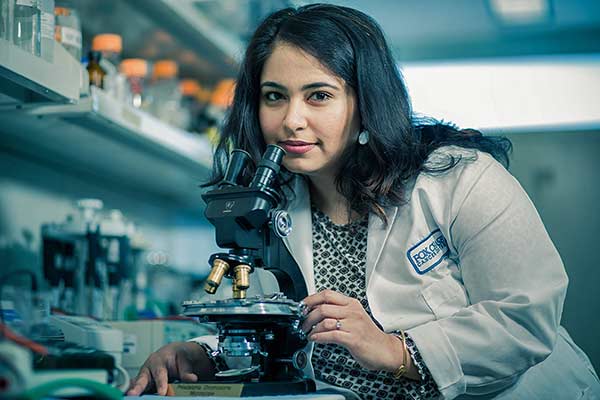
One aspect of Arora’s research focuses on ways to determine the effectiveness of treatments for colorectal cancer, with the ultimate goal of more individualized treatment and preventing some patients from being treated unnecessarily. Clapper is one of her mentors for that research.
In addition to her work in the lab, Arora also founded a professional development and networking group for women in science at Fox Chase in 2013. The group invites speakers in to discuss their career paths and challenges. “There are challenges that I’ve faced when I’ve worked on projects, and it’s been hard to move things forward sometimes. But having the right kind of mentorship has helped,” Arora said.
For Arora and her many female colleagues on the Fox Chase faculty, respect for facing such challenges is certainly well deserved.
